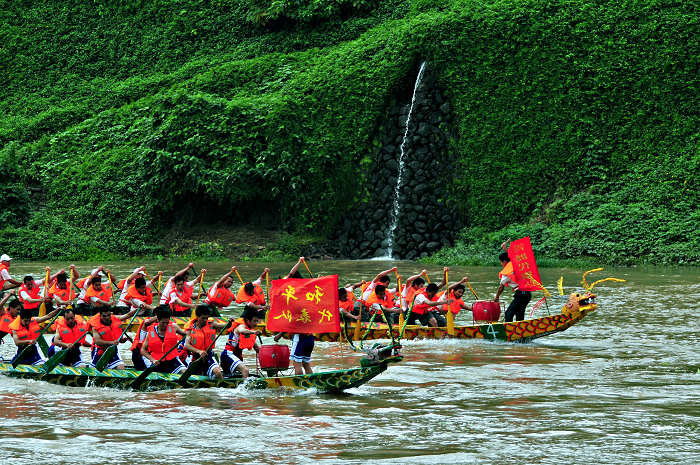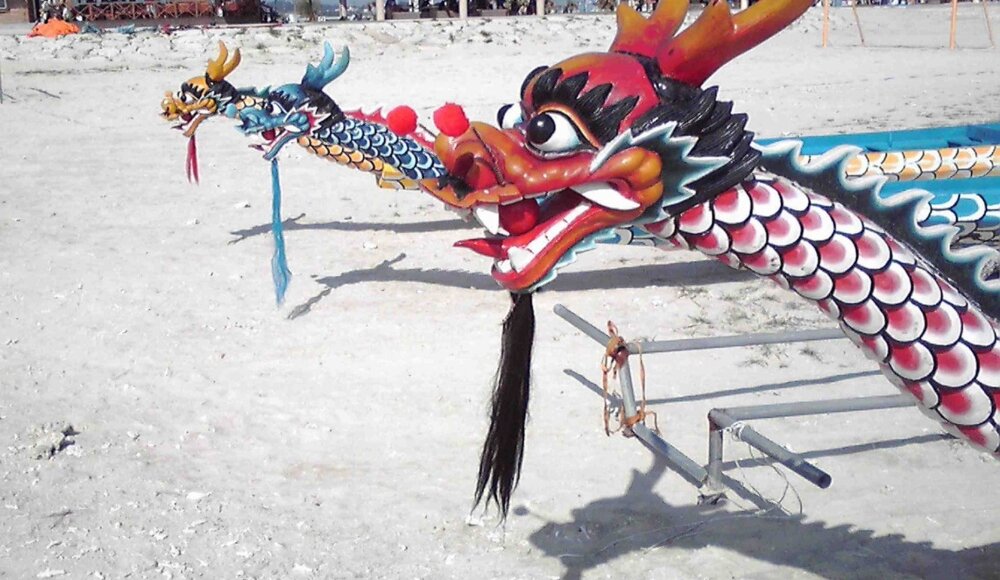Historical Background
The Dragon Boat Festival, also known as Duanwu Jie (端午節) in Chinese, stands as a revered traditional holiday deeply entrenched in the rich tapestry of Chinese culture and history. Observed on the fifth day of the fifth month of the Chinese lunar calendar, typically aligning with late May or June in the Gregorian calendar, this annual celebration bears profound significance, blending ancient customs, spiritual beliefs, and communal festivities.
Rooted in antiquity, the Dragon Boat Festival traces its origins to the revered poet and minister Qu Yuan, whose legacy reverberates through the annals of Chinese folklore. Qu Yuan, a prominent figure hailing from the southern state of Chu during the tumultuous Warring States Period, found himself embroiled in political strife and exile due to his impassioned opposition to alliances with the formidable state of Qin. Despite his noble intentions and steadfast dedication to his principles, Qu Yuan's unwavering stance against injustice ultimately led to his tragic demise.
Legend has it that in a gesture of desperation and profound sacrifice, Qu Yuan chose to end his earthly journey by plunging into the depths of the Miluo River. As news of his fate spread, the local populace, deeply moved by his unwavering spirit and profound commitment to righteousness, rallied together in a valiant effort to rescue him or retrieve his remains. Thus, the timeless tradition of dragon boat races was born—a spirited homage to Qu Yuan's enduring legacy and indomitable spirit.
Moreover, the Dragon Boat Festival is intertwined with a myriad of customs and rituals aimed at warding off misfortune and invoking blessings for the community. Central to these traditions is the consumption of sticky rice dumplings known as zongzi, meticulously wrapped in bamboo leaves and imbued with symbolism. As the legend goes, zongzi were hurled into the river to divert the attention of fish from consuming Qu Yuan's body—a symbolic gesture of reverence and protection.
In addition to dragon boat races and zongzi feasts, the festival encompasses a spectrum of practices rooted in ancient beliefs and spiritual customs. From hanging calamus, Artemisia, and garlic above doors to ward off malevolent forces to adorning homes with images of the five venomous creatures believed to emerge during this ominous period, each ritual serves as a poignant testament to the enduring resilience of Chinese tradition.
Over the centuries, the Dragon Boat Festival has evolved into a cherished cultural phenomenon, transcending geographical boundaries and uniting communities in shared celebration. Recognizing its profound cultural significance, UNESCO bestowed the honor of inclusion in the Intangible Cultural Heritage of Humanity upon the festival in 2009, affirming its enduring legacy as a cherished cornerstone of Chinese heritage.
In contemporary times, the Dragon Boat Festival continues to captivate hearts and minds, serving as a vibrant expression of cultural identity and communal solidarity. Through dragon boat races, zongzi feasts, and spirited festivities, people from all walks of life come together to honor tradition, celebrate unity, and pay homage to the timeless legacy of Qu Yuan and the enduring spirit of the Chinese people.

Dragon Boat Races at Longjiang, © 寒枫, via Wikipedia
Themes and Symbols in the Art of Dragon Boat Festival
Dragon Boat Racing: The Dragon Boat Festival's essence lies in the exhilarating spectacle of dragon boat racing, a tradition steeped in centuries-old lore and ritualistic fervor. Originating more than 2500 years ago in southern central China, this ancient ceremonial sport finds its genesis in the poignant tale of Qu Yuan, a revered minister of the Chu state during the tumultuous Warring States Period. As legend has it, Qu Yuan's tragic demise spurred the local populace to take to the waters in a spirited endeavor to rescue his body, birthing the tradition of dragon boat races as a timeless tribute to his noble spirit and unwavering resolve.
Zongzi: Complementing the adrenaline-fueled excitement of dragon boat races is the time-honored tradition of crafting and indulging in zongzi, or sticky rice dumplings. Symbolizing unity and familial bonds, these delectable treats are meticulously wrapped in reed or bamboo leaves, their pyramid shape a testament to the artistry and craftsmanship of generations past. With fillings ranging from sweet bean paste to savory eggs and meat, zongzi serves as a culinary homage to the diverse tastes and regional flavors of Chinese cuisine.
Celestial Harmony: As the sun reaches its zenith during the summer solstice, the Dragon Boat Festival offers a symbolic celebration of masculine energy and vitality. The sun, akin to the majestic dragon of Chinese mythology, embodies strength, resilience, and the triumph of light over darkness. Conversely, the moon, reminiscent of the graceful phoenix, represents feminine energy and renewal, creating a harmonious balance of yin and yang within the festival's cosmic tapestry.
Rituals of Protection and Prosperity: Moreover, the festival abounds with age-old customs and superstitions aimed at warding off malevolent forces and ushering in good fortune. From the application of realgar wine to repel poisonous creatures to the donning of colorful silk ribbons symbolizing the five elements, each ritual serves as a potent talisman against adversity and misfortune. Whether hanging icons of Zhong Kui, taking leisurely walks, or attempting to balance eggs at noon, these time-honored traditions serve as a poignant reminder of humanity's eternal quest for health, happiness, and spiritual harmony.
In Contemporary Art
As the echoes of the Cultural Revolution began to fade in the late 1970s, a new era dawned upon Chinese artists, one marked by the infusion of Western art history into the fabric of their creative expression. Amidst the radical social, political, and economic shifts of this period, contemporary Chinese art emerged as a dynamic force, resonating both within China and on the global stage. This transformative journey, from the underground genesis of the Cultural Revolution to the vibrant landscape of the contemporary art world, is a narrative steeped in innovation, experimentation, and cultural redefinition.

Ai Weiwei, Trees, 2010. Installed in Downing College, Cambridge, 2016. © Verbcatcher, via Wikipedia
In collaboration with curator John Tancock, Chinese artist and activist Ai Weiwei presents his monumental sculpture Tree as part of the exhibition "AI WEIWEI: Cubes and Trees" at Downing College, Cambridge. Constructed from dry, dead branches, roots, and trunks sourced from various tree species across southern China, Tree stands as a testament to Ai Weiwei's profound engagement with his homeland's natural environment and cultural heritage. Mimicking the form of a real tree, the sculpture's visible cuts and joins emphasize the diverse textures and patterns of bark, offering a tactile exploration of organic materials. Tree not only celebrates indigenous Chinese customs, such as the appreciation of distinctive tree trunks in markets, but also evokes the tranquility of traditional Zen gardens associated with Buddhism and Taoism. Reflecting on the Taoist ideal of harmony between man and nature, Ai Weiwei's sculpture serves as a poignant reminder of humanity's interconnectedness with the natural world. Furthermore, Tree prompts contemplation on the conceptual interplay between material and form in sculpture. While assembled from disparate tree components, the sculpture intentionally reveals its artificiality through visible joins, challenging viewers to reconsider their perceptions of nature and artifice. In this way, Ai Weiwei encourages audiences to confront complex social and environmental issues, including rapid urbanization and the erosion of traditional culture, within contemporary Chinese society.

Rock Number 59 by Zhan Wang, seen in the lobby of the British Museum in 2008 © Jynto, via Wikipedia
Zhan Wang's "Rock Number 59," displayed prominently in the lobby of the British Museum, stands as a captivating testament to the artist's innovative fusion of traditional Chinese culture with contemporary artistic expression. Wang's fascination with abstract forms, particularly in his "floating stones" series, reflects his exploration of the concept of the rock as a symbol of cultural heritage and vitality. Rock Number 59 is part of Wang's Artificial Jiashanshi series, which he began creating in 1995, featuring large, textured rock-like sculptures coated in chrome. This piece exemplifies Wang's technique of applying pliable steel sheets over natural rocks and hammering them to reproduce the original surface, thereby blurring the boundaries between nature and artifice. The mirror finish of Wang's sculptures imbues them with a mercurial, shape-shifting quality, evoking both the abstract works of Henry Moore and Barbara Hepworth and the boastful luxury sought by Jeff Koons. Through Rock Number 59 and his other artificial rock creations, Wang explores the intersection of new technologies and cultural traditions, offering a contemporary reinterpretation of Chinese history in a postmodern world.
The Dragon Boat Festival stands as a cherished cornerstone of Chinese heritage, weaving together ancient customs, spiritual beliefs, and communal festivities into a vibrant tapestry of cultural expression. From its origins in the poignant tale of Qu Yuan to its modern-day celebration as a UNESCO Intangible Cultural Heritage, the festival embodies the enduring spirit of Chinese tradition and unity. Through dragon boat races, zongzi feasts, and age-old rituals, the festival continues to captivate hearts and minds, serving as a testament to the resilience of Chinese culture amidst the currents of change. Furthermore, contemporary artists like Ai Weiwei and Zhan Wang offer innovative reinterpretations of tradition, blending ancient symbolism with modern artistic expression to create works that resonate with audiences around the world. As the Dragon Boat Festival perpetuates its legacy across generations, it remains a vibrant celebration of cultural identity, communal solidarity, and the timeless spirit of the Chinese people.


 Selena Mattei
Selena Mattei